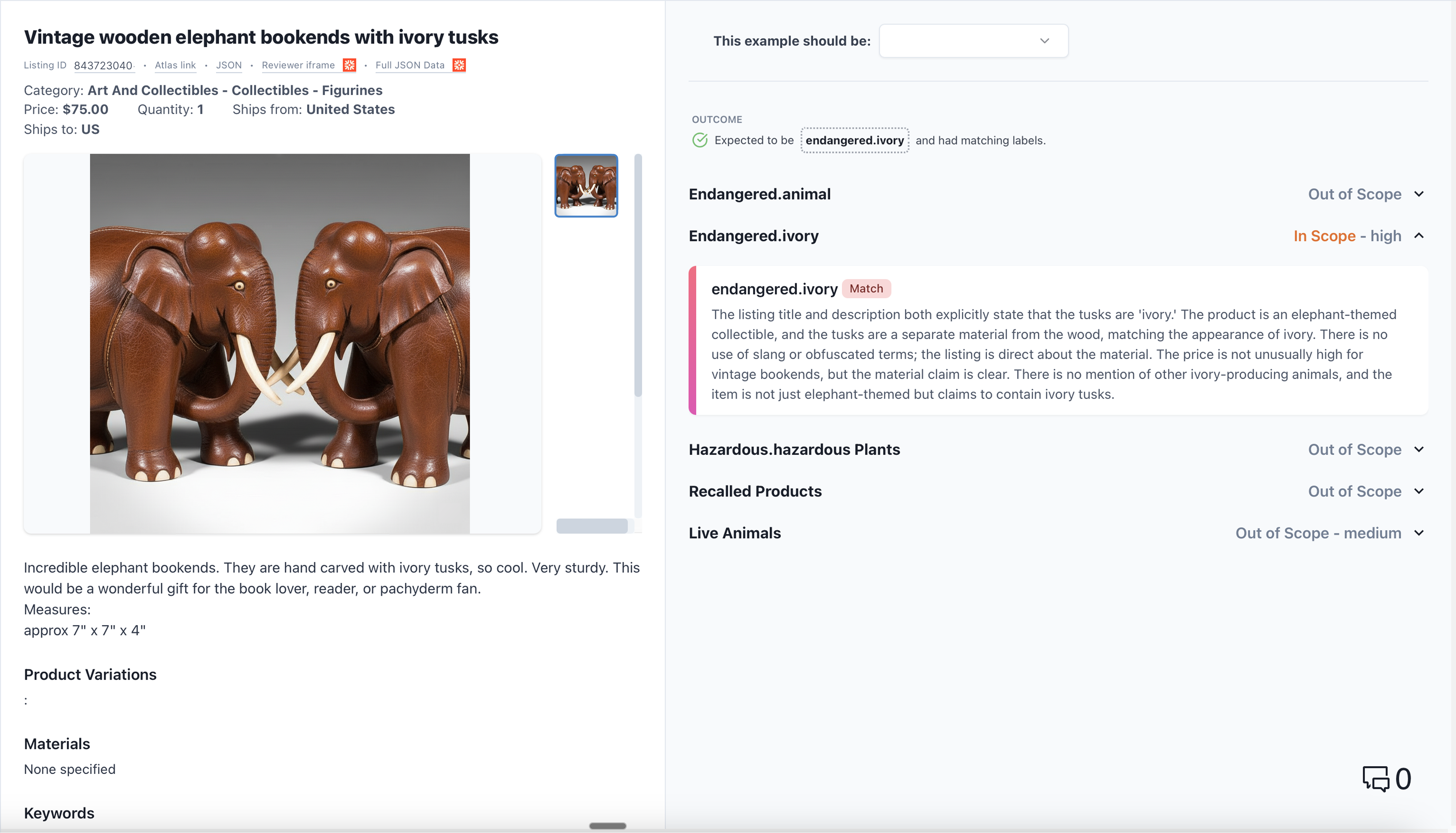How AI is Helping Marketplaces Combat Illegal Wildlife Trade
The illegal wildlife trade is a $23B global industry hidden across online marketplaces through coded language and deceptive imagery. SafetyKit’s AI detects endangered species and banned materials in real time, helping platforms remove 100+ violations daily with over 95% accuracy.
The illegal wildlife trade (IWT) is worth an estimated $23 billion and now heavily occurs through online marketplaces and content platforms. Traffickers exploit these platforms to sell live animals, endangered species, and animal-derived products using coded descriptions, false imagery, and misleading listings that disguise what’s being sold.
Traditional moderation isn’t equipped to keep up with evolving tactics of traffickers. Each undetected post exposes marketplaces to legal, reputational, and financial risk while fueling this destructive industry.
SafetyKit has partnered with the world’s largest marketplaces to tackle this challenge by integrating agentic AI in automated detection that protects both the platform and wildlife populations worldwide.
How Illegal Wildlife Trade Thrives on Online Marketplaces
Across thousands of online listings, traffickers use marketplaces and content platforms to sell live animals and endangered wildlife products disguised as legitimate goods. Listings for ivory, reptile skins, bird feathers, coral, and tortoiseshell are often labeled as “collectibles,” “vintage items,” or “decorative accessories” to evade detection.
These illegal wildlife trade networks rely on visual deception, coded language, and disintermediation to get around moderation systems. Sellers frequently operate through anonymized accounts and private channels, making enforcement difficult for online marketplaces and regulators.
In a BBC investigation, endangered African grey parrots were advertised openly on online marketplaces and content platforms, disguised under coded language and visual deception to evade legal detection. The investigation uncovered over 4,500 adverts for these parrots alone, demonstrating how traffickers exploit visibility across mainstream platforms.
Cases like this highlight how widespread and visible online wildlife trafficking has become and why marketplaces need systems capable of identifying violations before they surface.
SafetyKit’s Solution
Manual review is slow and expensive, and keyword filters miss listings that use multimodal content to conceal illegal activity. As a result, violations slip through, enforcement lags, and platforms face rising operational costs and reputational risk.
SafetyKit uses multi-modal analysis: a single LLM reviews all listings, interpreting content for policy violations and identifying prohibited goods across images and video. Continuous learning on platform-specific data further improves performance, and support for 193 languages removes translation delays.
For our marketplace customers, having access to an AI system capable of understanding listings across text, image, and video has enabled instant detection and removal of high-risk content before it surfaces, protecting brand integrity, strengthening regulatory compliance, and reducing the cost of manual moderation.
Model Training and Data Sources
SafetyKit’s models are trained using a combination of:
- Customer policies to align classification and enforcement with each marketplace’s internal rules.
- Historical data from thousands of detected violations in SafetyKit’s internal database, strengthening detection through real-world examples of keyword and image manipulation used to evade moderation.
- External databases such as CITES, ECOS, and the IUCN Red List to recognize protected species and restricted materials.
- Academic research and proposed CITES additions to stay ahead of emerging threats and species under review.
- Regional import and export restrictions for plants and animals, ensuring compliance with local regulations in every market.
This layered data approach enables accurate classification of protected species and materials even as trade tactics evolve.
With continuous learning, regional policy integration, and global language coverage, marketplaces can now enforce wildlife protection policies at scale with speed, accuracy, and confidence.

What is the Importance of human-in-the-Loop?
Human experts remain central to detection efforts to combat IWT. Trust and Safety teams define the policies that guide model behavior so enforcement reflects platform values, legal obligations, and ecological priorities. Expert oversight maintains quality, reviews edge cases, and keeps automated decisions aligned with policy intent.
Real-World Impact: From Listings to Ecosystem Protection
SafetyKit’s AI enforcement transformed wildlife protection overnight for our $10B marketplace customer. Within the first month of deployment, the system identified and began removing over 100 violations daily with an accuracy rate of >95%, enabling proactive screening before listings ever go live.
Along with protecting wildlife, the marketplace safeguarded their long-term stability by maintaining compliance, trust, and revenue integrity in an increasingly regulated digital economy.
Protecting Marketplaces and Wildlife with AI Enforcement
The fight against illegal wildlife trade requires both scale and precision, and now marketplaces can have both. SafetyKit’s agentic AI and human-in-the-loop systems turn complex global enforcement into an operational advantage.
Set up a demo with SafetyKit to learn how to build automated, policy-aligned enforcement that scales.
See how SafetyKit can help with moderation and fraud
Get a personalized walkthrough based on “How AI is Helping Marketplaces Combat Illegal Wildlife Trade”.

